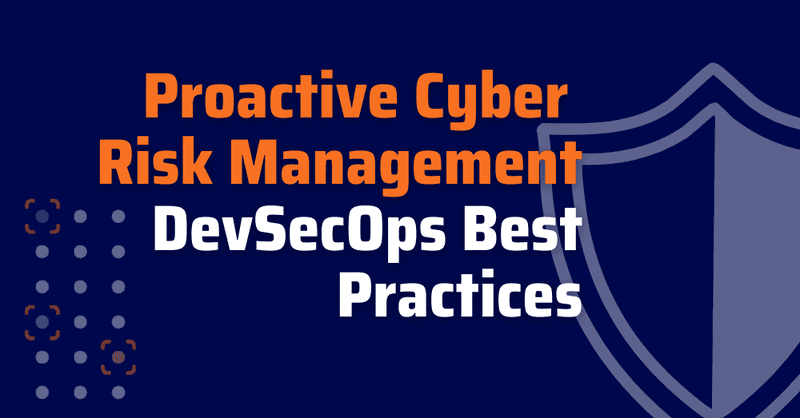The complexity of modern software development (which keeps growing) requires an advanced approach to security. Integrating DevSecOps—melding development, security, and operations—marks a shift from reactive to proactive cyber risk management, ensuring that security becomes an intrinsic part of the development lifecycle.
Cyber Security experts specialized in different areas shared their perspectives in our SafeDev Talk episode on the importance, challenges, and strategies for achieving this goal. Take a quick peek!
Following the insights of the webinar speakers, we are going to dive into effective cyber security risk management and present some of DevSecOps Best Practices. Keep reading!
Why Is Proactive Cyber Security Risk Management Essential?
As software pipelines grow more sophisticated and complex, the risks also escalate. As we will see later on, security in the DevOps pipeline is no longer just a bonus—it’s mandatory for sustainable and secure development. This reality underscores the need to address security vulnerabilities before they infiltrate production environments, minimizing both risks and costs.
The statistics back this up: IBM’s long-standing research indicates fixing a vulnerability post-deployment can be up to 100 times more costly than addressing it earlier in the lifecycle.
Tailoring Cyber Risk Management at Every Stage
1. Risk Variability Across Stages Risk is not monolithic; different types emerge at various stages of the Software Development Lifecycle (SDLC). For example:
- Development: Secrets and Insecure Coding Practices
- Integration: Vulnerabilities in dependencies or configurations
- Deployment: Misconfigurations in Infrastructure as Code (IaC)
- Production: Risks related to runtime exploitation or lateral movements
Each phase demands tailored security measures, from initial design threat modeling to runtime monitoring, and all must be aligned with zero trust principles.
2. Threat Modeling as a Cornerstone
The importance of threat modeling is undeniable. While its ideal application is during the requirements and design stages, its utility extends even to integration and post-deployment. You can always mitigate risks later, but the costs increase dramatically. The takeaway: better early than late.
Automation: The Backbone of Proactive Cyber Security Risk Management
With high volumes of vulnerabilities unearthed by modern scanners, automation has become indispensable:
- Detection and Prioritization Tools like SCA (Software Composition Analysis) and EPSS (Exploit Prediction Scoring System) provide dynamic, real-time assessments. EPSS, in particular, predicts the likelihood of a vulnerability being exploited, offering actionable insights for prioritization.
- Integration and Reporting Security insights must seamlessly integrate into existing workflows—be it through IDE plugins, ticketing systems like Jira, or Slack notifications. The motto must be: “Be where developers are”. The need for contextual and accessible alerts is undeniable too.
- Automated Remediation Some advanced systems even implement automated remediation for certain risks. For instance, automated dependency upgrades and policy enforcement can neutralize threats without human intervention.
Human Factors: Collaboration and Accountability
Despite the emphasis on tooling, the human element remains vital for a proper cyber risk management:
- Education: Developers must be trained not just on security tools but also on secure coding and best practices. As one panelist put it, “A developer who doesn’t understand secure design cannot build a secure system.”
- Accountability: With automated scanners generating massive vulnerability lists, prioritization depends on teams understanding the business impact of each risk. Agile teams often allocate 5–10% of their sprint time to addressing security, blending it with their existing bug-fixing processes.
DevSecOps Best practices for effective Cyber Risk Management
- Embed Security Early: From design to deployment, make security a natural part of every stage.
- Leverage Automation: Use tools not just for detection but also for prioritization, reporting, and even remediation.
- Educate and Empower: Equip teams with the knowledge and tools to integrate security without stifling agility.
- Adopt Dynamic Prioritization: Integrate EPSS or similar models to focus on vulnerabilities with the highest likelihood of exploitation.
Want to Dive Deeper into Proactive Risk Management in DevSecOps?
The insights that helped to shape this article were inspired by a discussion in our SafeDev Talk webinar. Join experts Emma Fang, Marudhamaran Gunasekaran, Luis García, and Jesús Cuadrado as they share their experiences, challenges, and strategies for integrating DevSecOps best practices into your development lifecycle.
Watch our SafeDev Talk Episode on Proactive Risk Management in DevSecOps and take the next step in securing your DevOps pipeline with expert advice and actionable takeaways!
The Future of Proactive Risk Management
Proactive cyber security risk management in DevSecOps isn’t just about tools or processes—it’s about aligning technology, people, and practices to create a secure and agile development environment. By embedding security into the DNA of your SDLC, organizations will be able to innovate with confidence, knowing that security isn’t a bottleneck but an enabler of growth.
As development pipelines grow more complex, the need for modern solutions that adapt to this complexity becomes imperative. Tools like Xygeni’s solution represent the future of security integration, helping organizations streamline practices, automate critical tasks, and embed proactive risk management throughout the SDLC. By aligning with DevSecOps best practices, these tools offer actionable insights and dynamic prioritization, empowering teams to preemptively address vulnerabilities without sacrificing development speed or agility. Do not wait anymore: implement DevSecOps best practices as soon as you can and enhance your cyber security risk management!

